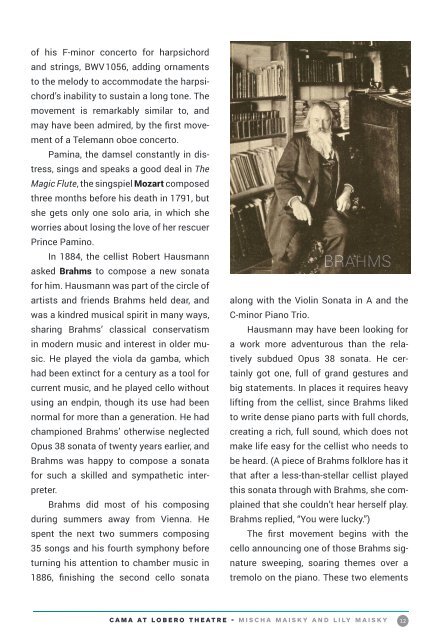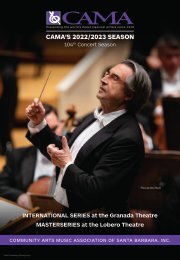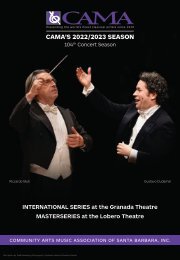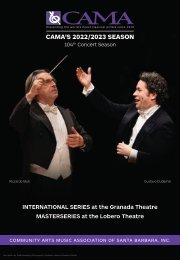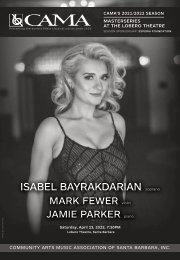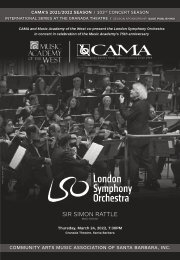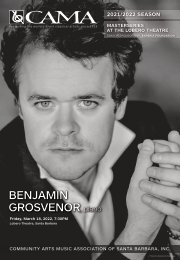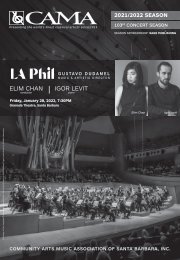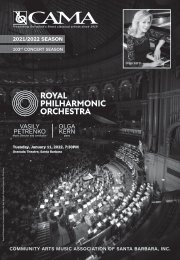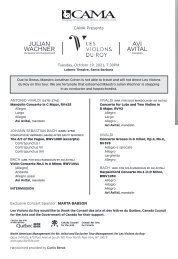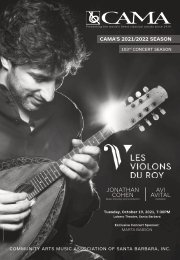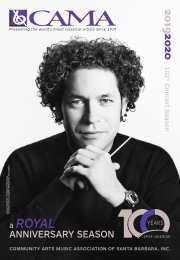May 6, 2019, Monday, 8:00 PM—Mischa Maisky, cello and Lily Maisky, piano—CAMA's Masterseries at The Lobero Theatre
MONDAY, MAY 6, 2019, 8:00 PM Mischa Maisky, cello Lily Maisky, piano Lauded by The Guardian for his “dazzling precision, fleet brilliance, and tender lyricism”, Latvian-born Israeli cello master Mischa Maisky is considered by many worldwide to be one of the handful of greatest living cellists. He has the distinction of being the only cellist in the world to have studied with both Mstislav Rostropovich and Gregor Piatigorsky and to carry on the deep musical legacy of these two great 20th Century Russian masters of the cello. His romantic emotion and absolute musical commitment carry the command of a true artist. It is fitting that Mischa Maisky will return by popular demand to the historic Lobero for the closing recital of CAMA’s historic 100th Concert Season. PROGRAM: Alessandro Marcello (arranged by J.S. Bach; and arranged for cello by Mischa Maisky): Movement II: Adagio, from Concerto in D minor, BWV 974 Johann Sebastian Bach (arr. S. Franco): Movement II: Largo, from Concerto for Harpsichord, Strings and Continuo No.5 in F minor, BWV 1056 Wolfgang Amadeus Mozart (arr. M. Maisky): Pamina’s Aria from The Magic Flute, K.620/Act II: “Ach ich fühl’s, es ist verschwunden” Johannes Brahms: Sonata No.2 in F major, Op.99 Pyotr Ilyich Tchaikovsky (arr. J. Stutschewsky and I. Thaler): No.10: October: “Autumn Song,” from The Seasons, Op.37a, TH 135 P.I. Tchaikovsky (arr. Viktor Kubatsky): No.6, “Valse Sentimentale,” from 6 Pieces, Op.51, TH 143 Dmitri Dmitriyevich Shostakovich: Sonata for Cello and Piano, Op.40
MONDAY, MAY 6, 2019, 8:00 PM
Mischa Maisky, cello
Lily Maisky, piano
Lauded by The Guardian for his “dazzling precision, fleet brilliance, and tender lyricism”, Latvian-born Israeli cello master Mischa Maisky is considered by many worldwide to be one of the handful of greatest living cellists. He has the distinction of being the only cellist in the world to have studied with both Mstislav Rostropovich and Gregor Piatigorsky and to carry on the deep musical legacy of these two great 20th Century Russian masters of the cello. His romantic emotion and absolute musical commitment carry the command of a true artist. It is fitting that Mischa Maisky will return by popular demand to the historic Lobero for the closing recital of CAMA’s historic 100th Concert Season.
PROGRAM:
Alessandro Marcello (arranged by J.S. Bach; and arranged for cello by Mischa Maisky): Movement II: Adagio, from Concerto in D minor, BWV 974
Johann Sebastian Bach (arr. S. Franco): Movement II: Largo, from Concerto for Harpsichord, Strings and Continuo No.5 in F minor, BWV 1056
Wolfgang Amadeus Mozart (arr. M. Maisky): Pamina’s Aria from The Magic Flute, K.620/Act II: “Ach ich fühl’s, es ist verschwunden”
Johannes Brahms: Sonata No.2 in F major, Op.99
Pyotr Ilyich Tchaikovsky (arr. J. Stutschewsky and I. Thaler): No.10: October: “Autumn Song,” from The Seasons, Op.37a, TH 135
P.I. Tchaikovsky (arr. Viktor Kubatsky): No.6, “Valse Sentimentale,” from 6 Pieces, Op.51, TH 143
Dmitri Dmitriyevich Shostakovich: Sonata for Cello and Piano, Op.40
- No tags were found...
Create successful ePaper yourself
Turn your PDF publications into a flip-book with our unique Google optimized e-Paper software.
of his F-minor concerto for harpsichord<br />
<strong>and</strong> strings, BWV 1056, adding ornaments<br />
to the melody to accommod<strong>at</strong>e the harpsichord’s<br />
inability to sustain a long tone. <strong>The</strong><br />
movement is remarkably similar to, <strong>and</strong><br />
may have been admired, by the first movement<br />
of a Telemann oboe concerto.<br />
Pamina, the damsel constantly in distress,<br />
sings <strong>and</strong> speaks a good deal in <strong>The</strong><br />
Magic Flute, the singspiel Mozart composed<br />
three months before his de<strong>at</strong>h in 1791, but<br />
she gets only one solo aria, in which she<br />
worries about losing the love of her rescuer<br />
Prince Pamino.<br />
In 1884, the cellist Robert Hausmann<br />
asked Brahms to compose a new son<strong>at</strong>a<br />
for him. Hausmann was part of the circle of<br />
artists <strong>and</strong> friends Brahms held dear, <strong>and</strong><br />
was a kindred musical spirit in many ways,<br />
sharing Brahms’ classical conserv<strong>at</strong>ism<br />
in modern music <strong>and</strong> interest in older music.<br />
He played the viola da gamba, which<br />
had been extinct for a century as a tool for<br />
current music, <strong>and</strong> he played <strong>cello</strong> without<br />
using an endpin, though its use had been<br />
normal for more than a gener<strong>at</strong>ion. He had<br />
championed Brahms’ otherwise neglected<br />
Opus 38 son<strong>at</strong>a of twenty years earlier, <strong>and</strong><br />
Brahms was happy to compose a son<strong>at</strong>a<br />
for such a skilled <strong>and</strong> symp<strong>at</strong>hetic interpreter.<br />
Brahms did most of his composing<br />
during summers away from Vienna. He<br />
spent the next two summers composing<br />
35 songs <strong>and</strong> his fourth symphony before<br />
turning his <strong>at</strong>tention to chamber music in<br />
1886, finishing the second <strong>cello</strong> son<strong>at</strong>a<br />
BRAHMS<br />
along with the Violin Son<strong>at</strong>a in A <strong>and</strong> the<br />
C-minor Piano Trio.<br />
Hausmann may have been looking for<br />
a work more adventurous than the rel<strong>at</strong>ively<br />
subdued Opus 38 son<strong>at</strong>a. He certainly<br />
got one, full of gr<strong>and</strong> gestures <strong>and</strong><br />
big st<strong>at</strong>ements. In places it requires heavy<br />
lifting from the cellist, since Brahms liked<br />
to write dense piano parts with full chords,<br />
cre<strong>at</strong>ing a rich, full sound, which does not<br />
make life easy for the cellist who needs to<br />
be heard. (A piece of Brahms folklore has it<br />
th<strong>at</strong> after a less-than-stellar cellist played<br />
this son<strong>at</strong>a through with Brahms, she complained<br />
th<strong>at</strong> she couldn’t hear herself play.<br />
Brahms replied, “You were lucky.”)<br />
<strong>The</strong> first movement begins with the<br />
<strong>cello</strong> announcing one of those Brahms sign<strong>at</strong>ure<br />
sweeping, soaring themes over a<br />
tremolo on the piano. <strong>The</strong>se two elements<br />
CAMA AT LOBERO THEATRE - MISCHA MAISKY AND LILY MAISKY<br />
12


